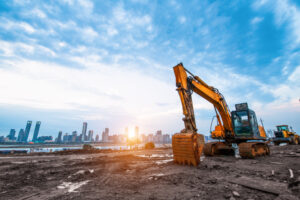Construction sites aren’t known for their cleanliness. From heavy machinery to fine particulate, construction generates plenty of contamination. When combined with rainfall, those pollutants wash away and cause adverse effects downstream.
This is a significant contributor to the destructive properties of stormwater runoff. As impervious surfaces increase, there exists less and less natural ground for rain to absorb. This causes rainfall to collect and flow into drains or streams. Passing through construction sites along the way only increases the concentration of pollution.
Still, there is much that construction sites can do. There are several best management practices (BMP) to help construction sites reduce stormwater runoff. Here are three of the best practices to employ at any site.
Minimized Site Disturbance
Improved site management is one of the most practical ways to manage stormwater runoff, including, specifically, using less invasive processes to keep the topsoil intact. Construction site waste contaminates the topsoil.
Destruction of natural vegetation exposes topsoil. It is more likely to wash away during the next storm when exposed. Keeping it contained and undisturbed is thus a vital step in preventing downstream contamination.
To avoid loose topsoil, focus on maintaining the existing vegetation and soil conditions. To do this:
- Only use heavy equipment in vital areas.
- Use ground protection when using the equipment.
- Work around trees, bushes, and other natural vegetation.
Trees, grass, and other forms of vegetation keep the soil hidden from flowing water and wind. Keeping such vegetation and its root structure intact is a critical first step for any construction site. For these same reasons, avoid grading or disrupting the land’s natural shape. The land is best able to handle rainwater in an undisturbed state.
If needed, break the job into smaller parts. Working quickly in smaller sections of the site avoids widespread ground destruction. Smaller working areas are also easier to manage, especially when monitoring wastewater.
Sand Filters
No matter how careful a site is, there will always be site disturbance. Knowing this, construction site managers must be proactive about their stormwater runoff protection. One particularly effective means of doing this is the use of sand filters.
Sand filters are treatment methods for wastewater high in pollutants. They exist as surface treatment options, or as subterranean cisterns, housed in multi-chambered concrete shells.
To avoid these pollutants from entering the water system, collect and store highly contaminated water until treatment. When using a sand filter, storing the water benefits the treatment, as the larger sediments will naturally separate from the water.
After storage and dispersal through the sand filter, the water settles and absorbs into the sand. This step traps up to 80% of suspended solids. As well, it prevents that sudden influx of water from eroding downstream channels.
At sites expected to be high in water contamination, sand filters are an effective solution. However, they are only as efficient as the professionals monitoring the wastewater.
Lapses in training or poor situation monitoring often lead to many site issues. Common problems include:
- Failure to monitor all pollutants in the site’s wastewater.
- Poorly tracked testing samples.
- Improper discharge monitoring for wastewater and impacted stormwater.
A site can avoid mishandling stormwater runoff with an active and monitored training program.
Porous Pavement
Another proactive stormwater BMP is the installation of porous pavement. It replaces traditional impervious surfaces like parking lots and sidewalks. In fact, when incorporated early, it keeps site activity and pollution contained to the site.
There are many forms of porous pavement, including:
- Pervious asphalt and concrete
- Interlocking pavers
- Plastic grid pavers
These surfaces combine with layers of sand and gravel to further filter absorbed water. Not only do porous pavement installations assist manage site runoff, however, they also help the surrounding area by soaking up and filtering pollutants.
Additionally, porous pavement mitigates snowfall and ice treatment. As snow melts, it will flow through the sand and other substrate layers. This will help to remove the various salts used to treat parking lots. And since road-treatment salts are bad for the environment, porous pavement options help to keep those salts out of the waterways.
Final Thoughts
There are several construction site BMPs for controlling stormwater runoff. Each site has different factors that influence how to handle stormwater. Though every site should take the steps to minimize site disturbance, this isn’t always possible.
These BMPs help construction sites manage the wastewater produced on-site, as well as containing and treating existing stormwater issues. Indeed, when construction sites act as responsible stewards of the land, the entire world benefits.
Rachel Perez is an Outreach Associate with Northstar Inbound.

